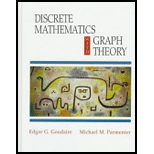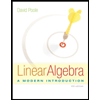
Discrete Mathematics with Graph Theory (Classic Version) (3rd Edition) (Pearson Modern Classics for Advanced Mathematics Series)
3rd Edition
ISBN: 9780134689555
Author: Edgar Goodaire, Michael Parmenter
Publisher: PEARSON
expand_more
expand_more
format_list_bulleted
Textbook Question
Chapter 5, Problem 24RE
Solve Exercise 23 using the method of generating functions described in Section 5.4.
Expert Solution & Answer
Want to see the full answer?
Check out a sample textbook solution
Students have asked these similar questions
What is the coefficient of x^n for the generating function (1)/(1+x)^2?
Consider the following Gauss elimination:
(a) Verify that the given functions
are linearly independent and form a basis of solutions of
the given ODE. (b) Solve the IVP. Graph or sketch the
solution
Chapter 5 Solutions
Discrete Mathematics with Graph Theory (Classic Version) (3rd Edition) (Pearson Modern Classics for Advanced Mathematics Series)
Ch. 5.1 - True/False Questions The statement i=1n(2i1)=n2...Ch. 5.1 - Prob. 2TFQCh. 5.1 - Prob. 3TFQCh. 5.1 - Prob. 4TFQCh. 5.1 - Prob. 5TFQCh. 5.1 - Prob. 6TFQCh. 5.1 - Prob. 7TFQCh. 5.1 - Prob. 8TFQCh. 5.1 - Prob. 9TFQCh. 5.1 - Prob. 10TFQ
Ch. 5.1 - Prob. 1ECh. 5.1 - Prob. 2ECh. 5.1 - Prove that it is possible to fill an order for n32...Ch. 5.1 - Use mathematical induction to prove the truth of...Ch. 5.1 - Prove by mathematical induction that...Ch. 5.1 - Use mathematical induction to establish the truth...Ch. 5.1 - 7. Rewrite each of the sums in Exercise 6 using...Ch. 5.1 - 8. Use mathematical induction to establish each of...Ch. 5.1 - 9. Use mathematical induction to establish the...Ch. 5.1 - Prob. 10ECh. 5.1 - Prob. 11ECh. 5.1 - Prob. 12ECh. 5.1 - Prob. 13ECh. 5.1 - Prob. 14ECh. 5.1 - Prob. 15ECh. 5.1 - Prob. 16ECh. 5.1 - Prob. 17ECh. 5.1 - Prob. 18ECh. 5.1 - Prob. 19ECh. 5.1 - Prob. 20ECh. 5.1 - 21. Prove the Chinese Remainder Theorem, 4.5.1, by...Ch. 5.1 - Prob. 22ECh. 5.1 - Prob. 23ECh. 5.1 - Prob. 24ECh. 5.1 - Prob. 25ECh. 5.1 - Prob. 26ECh. 5.1 - Prob. 27ECh. 5.1 - Prob. 28ECh. 5.1 - Prob. 29ECh. 5.1 - Given an equal arm balance capable of determining...Ch. 5.1 - Prob. 31ECh. 5.1 - 32. Let be any integer greater than 1. Show that...Ch. 5.1 - Prob. 33ECh. 5.1 - Prob. 34ECh. 5.1 - Prob. 35ECh. 5.1 - Prob. 36ECh. 5.1 - Prob. 37ECh. 5.1 - 38. For a given natural number prove that the set...Ch. 5.1 - 39. (a) Prove that the strong form of the...Ch. 5.1 - Prob. 40ECh. 5.1 - Prob. 41ECh. 5.2 - True/False Questions
If and for , then .
Ch. 5.2 - Prob. 2TFQCh. 5.2 - Prob. 3TFQCh. 5.2 - Prob. 4TFQCh. 5.2 - Prob. 5TFQCh. 5.2 - Prob. 6TFQCh. 5.2 - Prob. 7TFQCh. 5.2 - True/False Questions The Fibonacci sequence arose...Ch. 5.2 - Prob. 9TFQCh. 5.2 - Prob. 10TFQCh. 5.2 - Give recursive definitions of each of the...Ch. 5.2 - Find the first seven terms of the sequence {an}...Ch. 5.2 - Let a1,a2,a3,...... be the sequence defined by...Ch. 5.2 - Prob. 4ECh. 5.2 - Prob. 5ECh. 5.2 - Prob. 6ECh. 5.2 - Prob. 7ECh. 5.2 - 8. Suppose is a sequence such that and, for, ....Ch. 5.2 - Prob. 9ECh. 5.2 - Prob. 10ECh. 5.2 - Prob. 11ECh. 5.2 - Prob. 12ECh. 5.2 - Prob. 13ECh. 5.2 - Prob. 14ECh. 5.2 - Prob. 15ECh. 5.2 - Prob. 16ECh. 5.2 - Prob. 17ECh. 5.2 - 18. Consider the arithmetic sequence with first...Ch. 5.2 - Prob. 19ECh. 5.2 - Prob. 20ECh. 5.2 - Prob. 21ECh. 5.2 - Prob. 22ECh. 5.2 - Prob. 23ECh. 5.2 - Prob. 24ECh. 5.2 - Prob. 25ECh. 5.2 - Prob. 26ECh. 5.2 - Prob. 27ECh. 5.2 - Prob. 28ECh. 5.2 - Prob. 29ECh. 5.2 - Prob. 30ECh. 5.2 - Prob. 31ECh. 5.2 - 32. (a) Find the 19th and 100th terms of the...Ch. 5.2 - Given that each sum below is the sum of part of an...Ch. 5.2 - Prob. 34ECh. 5.2 - 35. Is it possible for an arithmetic sequence to...Ch. 5.2 - Prob. 36ECh. 5.2 - Prob. 37ECh. 5.2 - Prob. 38ECh. 5.2 - Prob. 39ECh. 5.2 - Prob. 40ECh. 5.2 - Prob. 41ECh. 5.2 - Prob. 42ECh. 5.2 - Prob. 43ECh. 5.2 - 44. Define a sequence recursively as follows:
...Ch. 5.2 - Prob. 45ECh. 5.2 - Prob. 46ECh. 5.2 - Prob. 47ECh. 5.2 - 48. Represent the Fibonacci sequence by , for...Ch. 5.2 - Prob. 49ECh. 5.2 - Prob. 50ECh. 5.2 - Prob. 51ECh. 5.2 - Prob. 52ECh. 5.2 - Prob. 53ECh. 5.2 - Prob. 54ECh. 5.2 - Prob. 55ECh. 5.2 - Prob. 56ECh. 5.2 - Prob. 57ECh. 5.2 - Prob. 58ECh. 5.3 - True/False Questions
The recurrence relation can...Ch. 5.3 - Prob. 2TFQCh. 5.3 - Prob. 3TFQCh. 5.3 - Prob. 4TFQCh. 5.3 - Prob. 5TFQCh. 5.3 - Prob. 6TFQCh. 5.3 - Prob. 7TFQCh. 5.3 - Prob. 8TFQCh. 5.3 - Prob. 9TFQCh. 5.3 - Prob. 10TFQCh. 5.3 - Solve the recurrence relation, , given .
Ch. 5.3 - Prob. 2ECh. 5.3 - Solve the recurrence relation, , given .
Ch. 5.3 - Solve the recurrence relation an+1=7an10an1, n2,...Ch. 5.3 - Prob. 5ECh. 5.3 - 6. Solve the recurrence relation, , given
Ch. 5.3 - 7. Solve the recurrence relation , , given .
Ch. 5.3 - 8. Solve the recurrence relation , , given ....Ch. 5.3 - 9. Solve the recurrence relation , , given ....Ch. 5.3 - 10. (a) Solve the recurrence relation , , given ....Ch. 5.3 - Prob. 11ECh. 5.3 - Prob. 12ECh. 5.3 - Solve the recurrence relation an=5an16an2, n2,...Ch. 5.3 - Prob. 14ECh. 5.3 - Prob. 15ECh. 5.3 - Solve the recurrence relation an=4an14an2+n, n2,...Ch. 5.3 - Prob. 17ECh. 5.3 - Prob. 18ECh. 5.3 - Prob. 19ECh. 5.3 - Prob. 20ECh. 5.3 - Prob. 21ECh. 5.3 - Prob. 22ECh. 5.3 - 23. The Towers of Hanoi is a popular puzzle. It...Ch. 5.3 - 24. Suppose we modify the traditional rules for...Ch. 5.3 - Prob. 25ECh. 5.3 - Prob. 26ECh. 5.3 - Prob. 27ECh. 5.4 - Prob. 1TFQCh. 5.4 - Prob. 2TFQCh. 5.4 - Prob. 3TFQCh. 5.4 - Prob. 4TFQCh. 5.4 - Prob. 5TFQCh. 5.4 - Prob. 6TFQCh. 5.4 - Prob. 7TFQCh. 5.4 - Prob. 8TFQCh. 5.4 - Prob. 9TFQCh. 5.4 - Prob. 10TFQCh. 5.4 - Prob. 1ECh. 5.4 - Prob. 2ECh. 5.4 - Prob. 3ECh. 5.4 - Prob. 4ECh. 5.4 - Prob. 5ECh. 5.4 - Prob. 6ECh. 5.4 - Prob. 7ECh. 5.4 - Prob. 8ECh. 5.4 - Prob. 9ECh. 5.4 - Prob. 10ECh. 5.4 - Prob. 11ECh. 5.4 - Prob. 12ECh. 5.4 - Prob. 13ECh. 5.4 - Prob. 14ECh. 5 - Use mathematical induction to show that...Ch. 5 - Using mathematical induction, show that
for all...Ch. 5 - Using mathematical induction, show that (112)n1n2...Ch. 5 - Prove that for all integers.
Ch. 5 - 5. Use mathematical induction to prove that is...Ch. 5 - 6. Prove that for all.
Ch. 5 - Prob. 7RECh. 5 - 8. (a) Give an example of a function with domaina...Ch. 5 - Give a recursive definition of each of the...Ch. 5 - Guess a simple formula for each of the following...Ch. 5 - 11. Consider the sequence defined by and for. What...Ch. 5 - 12. Find the sum.
Ch. 5 - 13. Let be defined recursively by and, for , ....Ch. 5 - Define f:ZZ by f(a)=34a, and for tZ define a...Ch. 5 - Consider the arithmetic sequence that begins...Ch. 5 - 16. The first two terms of a sequence are 6 and 2....Ch. 5 - 17. Let be the first four terms of an arithmetic...Ch. 5 - Explain why the sum of 500 terms of the series...Ch. 5 - 19. (a) Define the Fibonacci sequence.
(b) Is it...Ch. 5 - Show that, for n2, the nth term of the Fibonacci...Ch. 5 - Let f1,f2,....... be the Fibonacci sequence as...Ch. 5 - Suppose you walk up a flight of stairs one or two...Ch. 5 - 23. Solve the recurrence relation given that and...Ch. 5 - Solve Exercise 23 using the method of generating...Ch. 5 - 25. Find a formula for, given and for .
Ch. 5 - Let an be the sequence defined by a0=2,a1=1, and...Ch. 5 - Prob. 27RECh. 5 - Prob. 28RECh. 5 - Prob. 29RECh. 5 - 30. (For students of calculus) Let denote the...
Knowledge Booster
Learn more about
Need a deep-dive on the concept behind this application? Look no further. Learn more about this topic, subject and related others by exploring similar questions and additional content below.Similar questions
- In Exercises 5.6.1-5.6.17 find the general solution, given that y1 satisfies the complementary equation. As a byproduct, find a fundamental set of solutions of the complementary equation.arrow_forwardSection 31 #28 - Generalizing Exercise 27, show that if √a+√b ≠ 0, then ℚ(√a+√b ) = ℚ(√a,√b ) for all a and b in ℚ. [Hint: Compute (a - b) / ℚ(√a+√b ).] [Exercise 27 - Prove in detail that ℚ(√3+√7) = ℚ(√3,√7).] I have exercise 27 completed...how would I generalize this?arrow_forwardConsider the pictured Gauss eliminationarrow_forward
Recommended textbooks for you
- Algebra & Trigonometry with Analytic GeometryAlgebraISBN:9781133382119Author:SwokowskiPublisher:Cengage
 Linear Algebra: A Modern IntroductionAlgebraISBN:9781285463247Author:David PoolePublisher:Cengage Learning
Linear Algebra: A Modern IntroductionAlgebraISBN:9781285463247Author:David PoolePublisher:Cengage Learning Big Ideas Math A Bridge To Success Algebra 1: Stu...AlgebraISBN:9781680331141Author:HOUGHTON MIFFLIN HARCOURTPublisher:Houghton Mifflin Harcourt
Big Ideas Math A Bridge To Success Algebra 1: Stu...AlgebraISBN:9781680331141Author:HOUGHTON MIFFLIN HARCOURTPublisher:Houghton Mifflin Harcourt

Algebra & Trigonometry with Analytic Geometry
Algebra
ISBN:9781133382119
Author:Swokowski
Publisher:Cengage

Linear Algebra: A Modern Introduction
Algebra
ISBN:9781285463247
Author:David Poole
Publisher:Cengage Learning

Big Ideas Math A Bridge To Success Algebra 1: Stu...
Algebra
ISBN:9781680331141
Author:HOUGHTON MIFFLIN HARCOURT
Publisher:Houghton Mifflin Harcourt
Introduction to Integers,Maths - What are integers - English; Author: Mathispower4u;https://www.youtube.com/watch?v=04pURxo-iu0;License: Standard YouTube License, CC-BY
Integers-Middle School Math; Author: MooMooMath and Science;https://www.youtube.com/watch?v=DGWcWtqM_yk;License: Standard YouTube License, CC-BY